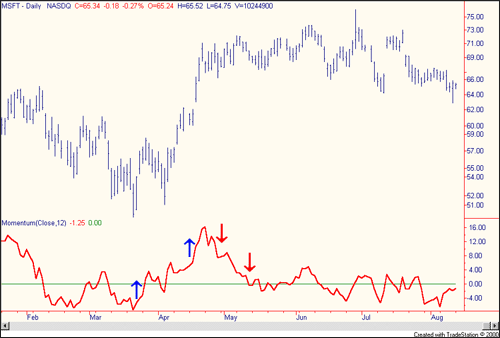Momentum, is perhaps the simplest and easiest oscillator to understand and use. Momentum is the measurement of the speed or velocity of price changes. In "Technical Analysis of the Financial Markets", John J. Murphy explains:
"Market momentum is measured by continually taking price differences for a fixed time interval. To construct a 10-day momentum line, simply subtract the closing price 10 days ago from the last closing price. This positive or negative value is then plotted around a zero line. The formula for momentum is:
| M = V - Vx |
Where V is the latest price, Vx is the closing price x number of days ago."
What it Measures
Momentum measures the rate of the rise or fall in stock prices. From the standpoint of trending, momentum is a very useful indicator of strength or weakness in the issue's price. History has shown us that momentum is far more useful during rising markets than during falling markets; the fact that markets rise more often than they fall is the reason for this. In other words, bull markets tend to last longer than bear markets. (For more, see Momentum Trading with Discipline.)
Technicians use a 10-day time frame when measuring momentum. You will see the zero line in the chart below. If the most recent closing price of the stock is more than the closing price 10 trading days ago, the positive number (from the equation) is plotted above the zero line. Conversely, if the latest closing price is lower than the closing price 10 days ago, the negative measurement is plotted below the zero line.
By measuring the differences of prices over a set period of time, we can start to recognize the rates at which the stock price is rising or falling. Momentum will help you recognize trendlines. Distinct trendlines develop as the stock price increases; a rising momentum plot line above zero indicates that an uptrend is firmly developing. A plot line starting to level-off indicates to technicians that the latest price of the stock is about the same as it was 10 days ago; thus, the velocity of the trend is slowing. The reversal is also true. (For related reading, see Riding The Momentum Investing Wave.)
It is important to understand that when the momentum indicator slides downward below the zero line and then reverses in an upward direction, it does not mean that the downtrend is finished. It merely means that the downtrend is slowing down. The same is true for the plotted momentum above the zero line.
 |
In the graph plotting Microsoft stock data from Feb 2001 to Aug 2001, a very clear trend develops in mid March. Over the next five weeks, the stock price moves in an extremely strong momentum from about $50 to $72-$73. A two-line simple moving average over the same period of time would show a clear crossover, indicating a strong buy entry point.
Conclusion
It is important to understand that momentum, albeit a very good indicator for determining price movement and subsequent trend development, must be used with other indicators to be an effective buy/sell indicator.
by Investopedia.com Staff